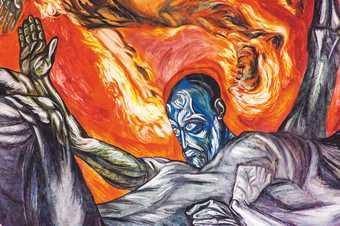
Detail of José Clemente Orozco's allegorical fresco depicting The Man of Fire 1936–9, from the ceiling of the chapel of Hospicio Cabañas, Guadalajara
age fotostock / Alamy Stock Photo
Until late in 2011, José Clemente Orozco (1883–1949) was mostly known to me as one of Mexico’s famous tres grandes, with Diego Rivera and David Alfaro Siqueiros. From afar, I saw the ‘three greats’ as largely indistinguishable from one another, a group of undeniably important artists whose work too frequently veered into technocratic political kitsch in service of the ambitions of the post-revolutionary Mexican state. To my mind they were a cautionary tale, one of many failed marriages between art and political ideology, the significance of their work hobbled by the compromises that collusion entailed.
Those assumptions were overturned when I went to Guadalajara to work with a ceramics workshop and my host suggested I see the 57 Orozco murals at the Hospicio Cabañas, painted between 1936 and 1939 under the quasi-Marxist government of Lázaro Cárdenas del Río. I was listless and bored waiting for my first experiments to emerge from the kiln, so I went, expecting little more than an afternoon of pleasant connoisseurship. Instead what I found was an incendiary and complex version of populist modernism that was unknown to me.
In truth, Orozco was neither a parochial nationalist nor an academic. In his pursuit of an iconography of postcolonial Mexican identity, his work neither eschewed formal complexity, nor did it glorify a pre-colonial past or shy away from depicting the suffering caused by the carnival-barkers of ideological purity who dominated his present. He greeted such purity with biting scepticism, and progressive activists and conservative authoritarians alike garnered his substantial ire. The Cabañas murals depicted the mechanisation of work, war and divisive politics in the stark language of modernist formalism, which cut apart and flattened figures in a manner as brutal as the gears of the factory or the bullets of the Gatling gun. What proved unmistakable was that Orozco’s art was unsparingly self-reflexive, ever implicated in the societal transformations it depicted.
Orozco’s most significant work does not appear on easily portable canvases; it can’t be circulated through the art market or trafficked from one museum to the next. It was as committed to its place as it was its time. It reminds me that art too often operates from a comfortable remove, and that when we look at art, we often do so in isolation, via our screens or the occasional visit to silent halls of contemplation. In an age when our sites of public exchange are increasingly individualised, surveilled and subject to private corporate interest, work that resists isolationism and embraces the tough calamity of the commons is all the more relevant. Returning to it now reminds me where all art achieves its greatest agency: among people and in the public domain, where the desire for equality and ethics are felt most viscerally, and the stakes of artistic practice are abundantly clear.
Walead Beshty is an artist who lives and works in Los Angeles. A selection of his work is on display at Tate Modern until 1 December.
